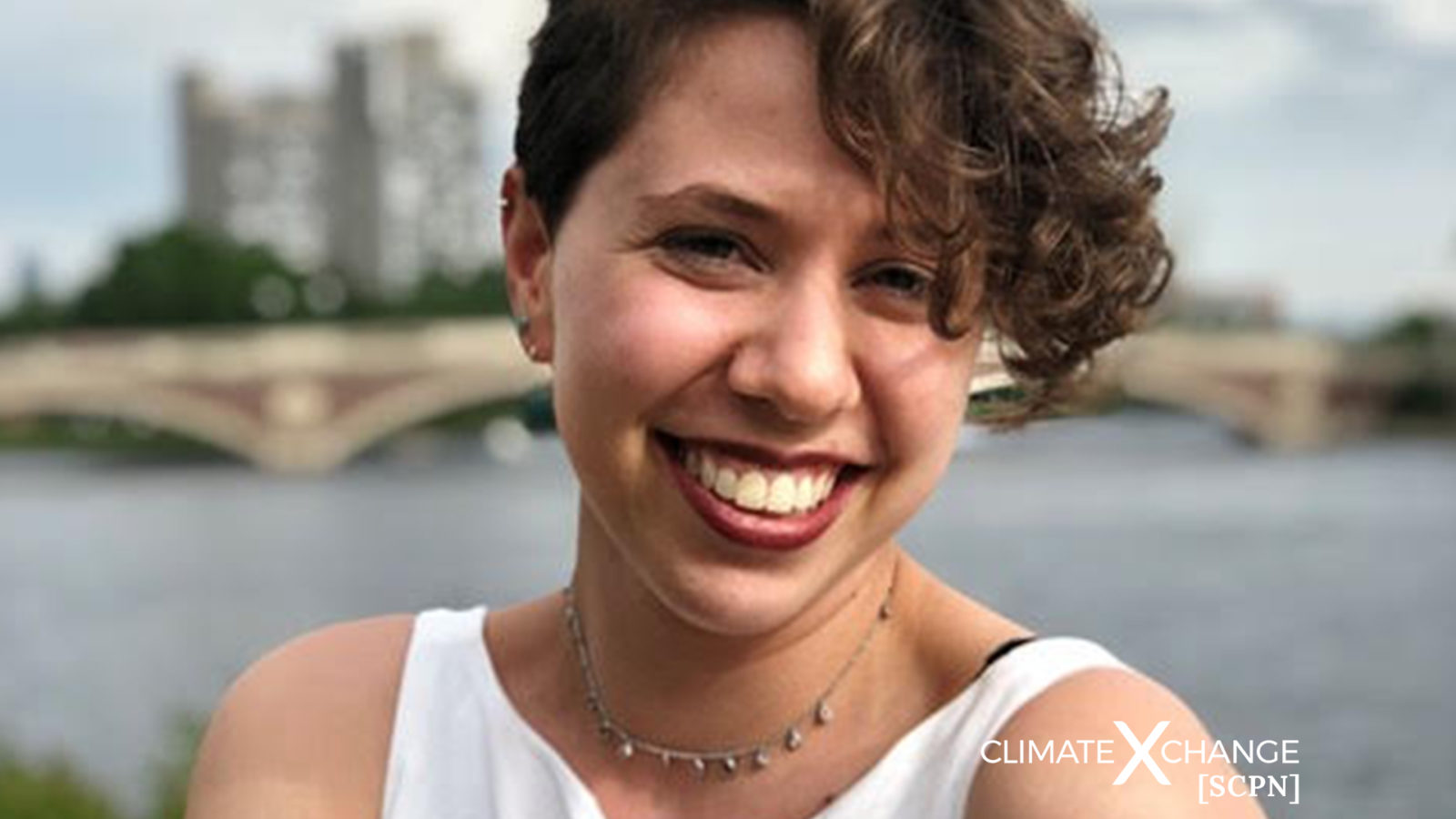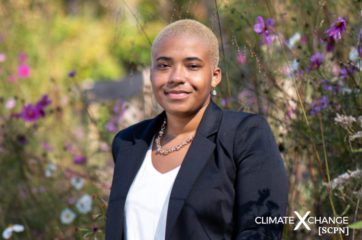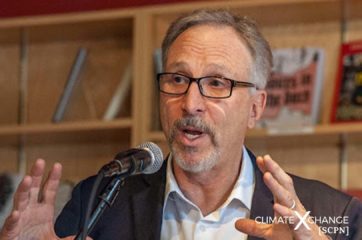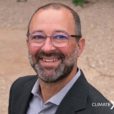All across the country, members of our State Climate Policy Network (SCPN) are fighting to make an impact on climate change in their communities. We have individuals in our Network from all 50 states, each experiencing climate change differently in their local areas and finding unique solutions to build resiliency efforts.
Yasmin Yacoby is the Program Manager for Energy Justice at the Rhode Island Office of Energy Resources. She is also a Govern for America Fellow.
This interview has been edited for brevity and clarity.
Naomi Shimberg
Let’s start with going into your story. Can you guide me through the path to where you are today. What are your passions and what led you to your work on energy justice?
Yasmin Yacoby
I’ll start by saying I come from a large family. I have three siblings, and we love to hike. Throughout my childhood, every other summer we would go hiking, on multi-day treks. It’s one of the things that we enjoy doing most. I think that’s partly where my passion for the environment and environmental science came from.
Growing up in Israel, I spent most of my childhood outside after school, hanging out with friends in the park and riding around on my bicycle and just enjoying the weather and loving being outdoors.
We moved to the United States when I was 11 years old, and I had this interest in environmental science and now it was being taught at my school. I started taking environmental science classes in high school and decided that that’s what I wanted to major in. Originally I was interested in conservation biology and really cared about saving the planet — that was really the number one thing for me. There were all these species that, because of us, were going extinct and that just didn’t seem fair.
But there was this one conversation in college that really stood out to me. I was in a course about environmental policy, which is what I was studying: environmental science and public policy. We were grappling with this question: Should trees have the same rights as people do?
And I thought, absolutely. Why shouldn’t trees have rights? They are living organisms and we are cutting them down faster than we can replant them. They should have the right to exist.
I brought this up with a group of friends over dinner one day. One of them gave me a funny look and said, “Shouldn’t all people have equal rights before trees also have rights?”
And that really stuck with me. This was one of the bigger turning points I had in life. I started researching and learning. It helped that my friends were all understanding and helped me along in my journey of coming to terms with the privilege I had and the lack of understanding that I had of the different kinds of injustices that existed. After that, I changed my focus to environmental justice and started exploring how different policies were exacerbating environmental injustice.
Naomi Shimberg
You’re currently the program manager for Energy Justice at the Rhode Island Office of Energy Resources. What led you to that position?
Yasmin Yacoby
That turning point I mentioned happened during my sophomore year of college — I started to grapple with the ways in which the environmental sphere was unjust. At that same time, former President Trump also got elected, and that just hit me really hard. I realized that government was where I wanted to situate myself — that government could make a difference and it was not fulfilling its duty right now of serving all people. It was serving some and definitely not others.
As I was finishing up my studies, I applied for a fellowship called Govern for America. Govern for America is like a matchmaker — it takes young people and places them in high impact roles in government. Its focus is on creating social change and It placed me with the Office of Energy as their energy justice program manager. This was an interesting transition for me, because my focus had never been on energy justice — it was on environmental justice. I quickly learned that the tenants that applied to environmental justice were not so different than those that applied to energy justice, and that the intersections between those fields and other social justice fields would make for a smooth transition.
Naomi Shimberg
How is environmental justice different from energy justice? What issues might fall under one that don’t fall under the other? Is one a subsect of the other?
Yasmin Yacoby
Energy justice is almost like a subset of environmental justice, but really they’re more like a Venn Diagram. They have a lot of overlap, but they are different. Just like environmental justice is the understanding that everybody should have a right to clean air and clean water and that nobody should unequally bear the burden of climate change, energy justice says that all people should have a right to clean, affordable, and dependable energy, and a say in shaping their energy future.
Just like environmental justice is the understanding that everybody should have a right to clean air and clean water and that nobody should unequally bear the burden of climate change, energy justice says that all people should have a right to clean, affordable, and dependable energy, and a say in shaping their energy future.
Energy is a human right, especially in New England. Surviving the winter or the summer without heat or air conditioning as climate change is getting worse and temperatures are getting more variable is really dangerous and people have died. We’re seeing this all around the country.
More importantly, energy justice and environmental justice are tied very closely to a lot of other social justice fields. Energy justice is very directly tied to racial justice because of decades and centuries of discriminatory policies and legacies of racism that have shaped our energy industry. It’s also tied to housing justice and tenants’ rights. It’s not a standalone issue and there’s a lot of intersectionality and overlap.
Naomi Shimberg
I’m curious about what you’re working on in terms of energy justice at the Office of Energy Resources (OER). What are the main projects now and what do you hope to achieve?
Yasmin Yacoby
I’ve shaped this role into two work streams. The first work stream focuses on the internal work and the second is on the external work.
The internal work is understanding the overlap and the connections between environmental justice and energy justice and social justice and racism and structural inequities — and making those connections between the work that we are doing in order to make better policies.The goal is to recognize that without the understanding and the active intent to dismantle the racist and discriminatory systems that are currently in place, we’re not going to go anywhere, and we’re only going to continue to reinforce these systems. A lot of my work, therefore, has focused on diversity, equity and inclusion, and understanding what that looks like in our office and out of our office. It has focused on introducing concepts like targeted universalism and intersectionality to the folks I work with and urging them to consider oppressive structures in their program and policy design and planning. It has focused on facilitating conversations about racism and social justice, and bringing in training and opportunities to undo racism.
The external side of the work is directly tied to the internal. It’s working with communities and uplifting their voices. It’s finding a way to make our public participation processes more accessible and equitable, and making sure that those voices that have been historically marginalized and fourthly left out of the conversation are front and centered and uplifted. And we can’t reach out to communities and prioritize them without first understanding the structural barriers that are in place for them to participate in the programs we offer and to benefit from the policies we create. These two work streams also tie in to the key tenets of energy justice: procedural justice, distributive justice, and recognition justice.
This work is never ending. It’s ongoing and we are just at the tip of the iceberg. I’ve been with OER for over a year and a half now and we have barely started. It’s an important journey, but it won’t happen overnight.
Naomi Shimberg
How has the energy justice movement evolved during your one and a half years at the Office of Energy Resources. How do you see it developing or growing over the next few years and into the future?
Yasmin Yacoby
The energy justice movement is always evolving and growing because it’s not something that’s set in stone. It’s based on the needs of the communities that are experiencing injustice. At certain times, energy justice looks like lowering utility bills. At other times it has nothing to do with utility bills and it has everything to do with where your power is coming from and wanting to contribute to lowering greenhouse gas emissions.
I think this movement is ever-evolving, but the three tenants that support energy justice have stayed strong. Those are distributive justice, procedural justice, and recognition justice. Each of those plays a role in making sure that the work towards energy justice happens correctly.
Distributive justice is the idea that everybody should experience the same costs and benefits from the energy sphere. Procedural justice is making sure that everybody has a voice to say whether they agree with the choices being made. And recognition justice is understanding that there have been these historic inequities and these inequities persist and that we need to actively be undoing them and addressing them consciously.
In terms of the energy justice movement growing and developing over the next couple of years, I don’t know. I think that there is a lot of room for it to be shaped. But it’s really not up to me. It’s up to the frontline communities and environmental justice communities to say where it needs to go and how it needs to happen.
Naomi Shimberg
What is a “just transition?” Why do you believe that justice and equity must be at the forefront of energy reform?
Yasmin Yacoby
A just transition is a transition away from an extractive economy to a regenerative one. It puts equity front and center and it puts people front and center, not things or objects or capital. It’s the only way to move forward.
A just transition is a transition away from an extractive economy to a regenerative one. It puts equity front and center and it puts people front and center, not things or objects or capital. It’s the only way to move forward.
At the end of the day, there is no single element of the energy system that was designed to truly benefit low-income folks and people of color. Just as with all systems, there was no intentionality in eradicating racism and discrimination from the energy system. And so by default, racism was built into the energy system, and it’s proven to be detrimental to so many communities.
Without intention, without an active fight, without placing justice and equity at the forefront of our transition, the policies we create will continue to harm frontline communities. Or, at best they will be structurally inaccessible to those communities because of our societies’ oppression and marginalization of people of color and low income communities.
I see this as an amazing point in time that we’re in right now. We have a chance to recreate our entire energy system. We have a chance to redesign it. But without intention, without equity at the epicenter, we will design it to be unsustainable. It’s going to continue to extract and oppress those same communities that have experienced that oppression up until now.
I see this as an amazing point in time that we’re in right now: we have a chance to recreate our entire energy system. We have a chance to redesign it, but without intention—without equity at the epicenter—we will design it to be unsustainable.
Naomi Shimberg
You graduated from college in 2019. As a young person, what do you think our generation should strive towards in the pursuit of energy, energy equity, and justice? What does our generation have to add to the movement?
Yasmin Yacoby
I think we can bring forward this understanding that energy equity and racial justice are one in the same. There is so much intersectionality between these two fields that if we address energy equity without an eye towards racial inequity, we’re going to continue to perpetuate harm.
I also think that we can teach the older generations that urgency is not the enemy of equity. Change is happening and we know that it’s happening fast. But we’ve seen decades of policies that are created quickly and haphazardly with no review or proper accountability towards the communities they will be harming. Those policies — even if they were created with the intention to address equity — have continued to do harm and to perpetuate inequities.
If we really want to reach true sustainability, we have to do so with equity in the center. We have to center frontline communities and environmental justice communities. Yes, it’s urgent, but if we do it poorly, it’s going to be so much worse than it currently is.
Energy equity and racial justice are the same thing. Urgency does not mean we need to do it wrong. It means we have to do it right.
Naomi Shimberg
I’m curious what you’re hoping to work on in the coming years. Is there anything else you’d like to highlight about your own work or the work of the Rhode Island Office of Energy Resources?
Yasmin Yacoby
I want to break down the power structures that exist within government that are in the way of communities participating and shaping their energy futures.
I think there’s reluctance to bring in community expertise, community voices, and local knowledge because of this perception that energy is a technical field, and that it is only for those who have studied it extensively or who are economists or who are engineers. This isn’t true. Energy touches every single one of our lives in so many ways.
I think there’s reluctance to bring in community expertise, community voices, and local knowledge because of this perception energy is such a technical field…This isn’t true. Energy touches every single one of our lives in so many ways.
It can really be the difference between life and death for some. We need to start figuring out how to bring those voices in and how to respect them. This is something that I want to start seeing within local, state, and federal governments. I want to find ways to uplift communities, to trust their process — not ours — and to follow their lead. I want to recognize that they probably know better than us when it comes to how to heat their own home.
There’s all this knowledge that is untapped and waiting to be accessed. There are some amazing people who are already fighting this fight. There are folks in Rhode Island who are on the ground every day organizing and really working towards a better future. I want to work towards working with them. I want to be able to work with them. I want to not have barriers in place to work with folks who deserve to be paid for their work and deserve the recognition for all of the hard work that they’ve done.









